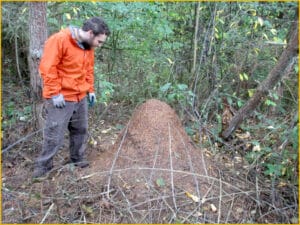
The topic continues to be thatch ants who, as we have seen, build enormous domiciles for themselves and their friends. The top part of the abode is a mound secured with dried plant matter, and the living quarters extend into underground tunnels and rooms. All the babies are kept in the central brood chamber. The sun warms the upper part of the home, while underneath, the decay of organic material generates heat. The ants forage for food at ground level, and also high up in trees.
If nearby plants try to encroach and grab too much territory, the ants poison them. An impressive thatch ant colony in Oregon consisted of 210 nests, covering four hectares (almost 10 acres or 48,000 square yards) of ground, and inhabited by probably 56 million individuals. Under normal circumstances, the acute, immediate stress of a predatory incursion rouses the worker ants to mount a vigorous defense of the colony. Against bird, bear, or whoever bothers them, they stand their ground.
If humans poke around, the ants will directly attack:
When a colony was disturbed the surface of the mound was soon covered with workers. Many assumed the defensive position: head up and mandibles widely spread; gaster turned forward under the thorax and ready to spray formic acid into any wound made by the mandibles. Many workers started spraying at the beginning of the disturbance and soon there was an invisible cloud of formic acid vapor above the nest that was irritating to human eyes and noses. The bites of the workers were also annoying.
But priorities can change. Three months after a wildfire had devastated an area, researchers studied thatch ant colonies that had suffered the loss of food sources and beneficent foliage cover, along with massive damage to the aboveground parts of their dwellings:
Many ants were directly killed by the fire […] but some ants survived in underground portions of the nest. We show that the behavioral fight-or-flight response of ants is altered…
After the fire, and after many weeks of living in an atmosphere of chronic stress, the ants manifested an altered response to events that caused acute stress. They became much more likely to flee from aggression, and much less inclined to fight. Their reaction proposes a big, intriguing question.
Could this response also serve a positive purpose? After all, thatch ants have elegantly dealt with so many other issues. Maybe the apparent discouragement is a necessary phase that gives the community a chance to pause, process the current reality, and form a consensus for change. Maybe this is nature’s way of telling them to get out of there and establish a new colony. Basically, we don’t really know what’s going on with them, except that they have been working on their game plans for millennia.
Are animals competent?
An animal will sometimes respond to a threat by doing essentially nothing; grass-picking or some other action that humans call displacement behavior, and regard as a substitute for action they consider more correct. Human observers give the animals a failing grade because they don’t engage in combat or run away, or whatever we have decided they should properly do.
Can we justify labeling the actions as inappropriate, when it might be that we simply don’t understand? In the face of horrendous threats, many animals comport themselves quite capably. Maybe they know exactly what they are doing when they pick at grass, too, or engage in some other action that seems random, out of context or incorrect to us. As oblivious bipeds who don’t know enough to flee from a tsunami, are we really authorized to make rulings about acceptable, effective threat responses?
Everything that behavioralists believe about human drives, and the human tendency to practice displacement activities, may be perfectly valid. Still, it seems rather unfair to take these judgment errors and lay them at the door of animals, who generally seem to have a pretty good handle on things.
Your responses and feedback are welcome!
Source: “Formica obscuripes,” AntWiki.org, undated
Source: “Climate change and wildfire-induced alteration of fight-or-flight behavior,” ScienceDirect.com, July 2021
Image by Upupa4me/CC BY-SA 2.0

 FAQs and Media Requests:
FAQs and Media Requests: 











